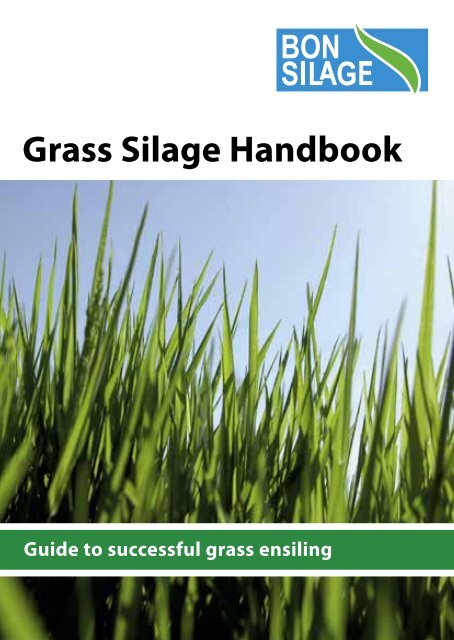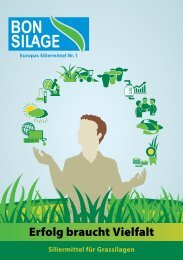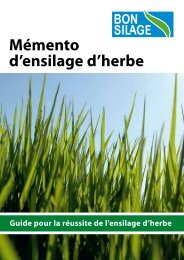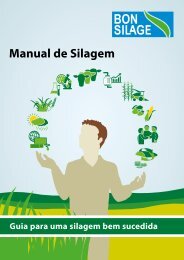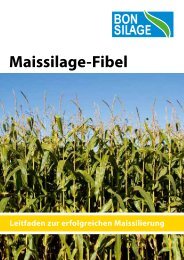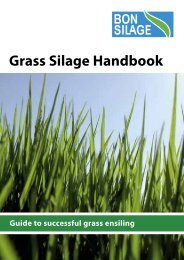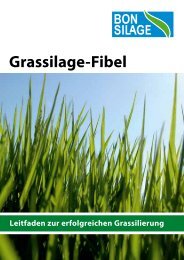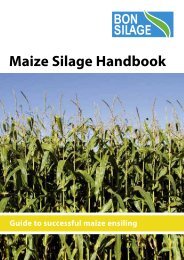Create successful ePaper yourself
Turn your PDF publications into a flip-book with our unique Google optimized e-Paper software.
<strong>Grass</strong> <strong>Silage</strong> <strong>Handbook</strong>Guide to successful grass ensiling
Contents1. Target valuesGuide to successful grass ensiling1. Target values 32. <strong>Grass</strong>land maintenance 43. Cutting time 54. Cutting height 65. Wilting 76. Lying time in the field 87. Chop length 9This grass silage handbook covers all the main managementfactors for the production of top feed quality grass silages.The target values for the main parameters of top-quality grasssilage are shown below.Requirements for grass silagesParameterTarget ValueDry matter % 28-35pH value (function of DM) 4.0-4.8Sugar % DM < 4XP % DM 14-18XF % DM 23-26NDF % DM 42-48XA % DM < 10NH 3-N % of total N < 8ELOS % DM > 68Gas formation ml/200 mg DM > 50Energy Density MJ NEL/kg DM > 6.28. Ensiling agents 109. Dosing technology 1310. Compaction 1511. Covering 1612. Silo face 1713. Economic efficiency 1814. Product range 19Note: high silage quality is the basis for top production performance3
6. Lying time in the field7. Chop lengthThe lying time in the field should be less than 24 hours in orderto keep energy losses as low as possible. Every additional nightleads to sugar consumption through respiration.The weather risk (rain) is reduced.Dry matter losses as a function of time in the fieldDM losses, %2018161412108642012 hours48 hoursLying time in the fieldCrumbling lossesErosion lossesRespiration lossesOptimum chop length for grass silage: 30-40 mmToo long chop lengths make compaction more difficult.The knives and contra-rotating blades should be sharpenedat regular intervals.The optimum chop length is essential for:n Precision compacting, more efficient use of the silo spaceand lower losses.n Better plant cell decomposition and thus more intensive,faster lactic acid fermentation.n Reduced gas exchange on opening the silo and thus lowerrisk of subsequent fermentation.n Improved feed uptake.Short lying times in the field:n Reduce losses due to respiration, crumbling and erosion.n Avoid carbohydrate losses and promote the ensiling process.n Improve the energy density and digestibility.n The use of mower-conditioners speeds up wilting. In warmweather the optimum crop DM content is soon exceeded.Note:a short lying time in the field optimises the energy yield per hectare.8Note: the optimum chop length is the basis of good compaction,intensive fermentation and high feed uptake.9
8. Ensiling additivesBesides the basic rules of ensiling, ensiling agents work in differentways to assist the fermentation processActive ingredients: homofermentative lactic acid bacteriaAim of use: optimum course of fermentation, higher energy density,better feed performanceArea of use: grass, clover-grass, alfalfa, green rye, TPS, 22-45 % DMPack size: granules 25 kg, liquid 50 gDose/t: granules 0.5 kg, liquid 1 gRecommended compaction: at least 180 kg DM/m 3Minimum storage time: 2-3 weeksActive ingredients: Combination of homofermentativeand heterofermentative lactic acid bacteriaAim of use: rapid lactic acid formation, more digestible energy,aerobic stabilityArea of use: grass, clover-grass, alfalfa, green rye, TPS, > 30 % DMPack size: granules 25 kg, liquid 50 gDose/t: granules 0.5 kg, liquid 1 gRecommended compaction: at least 180 kg DM/m 3Minimum storage time: 6-8 weeks10The provenbasic productFor greater stabilityand energyGroup 1bGroups 1c, 2, 4bAll BONSILAGE products are approved for use in organic farming.The silage professionalfor wet silageActive ingredients: homofermentative lactic acid bacteriaAim of use: rapid, stable lowering of the pH value, use of the entirehydrocarbon spectrum, inhibition of Clostridium growthArea of use: ryegrass 18-35 % DM, other grasses 22-35 % DM,clover-grass 25-35 % DM, alfalfa 30-35 % DMPack size: granules 25 kg, liquid 100 gDose/t: granules 0.5 kg, liquid 2 gRecommended compaction: at least 180 kg DM/m 3Minimum storage time: 2-3 weeksThe specialist forsugar-rich grassesActive ingredients: Combination of homofermentative andheterofermentative lactic acid bacteriaAim of use: reduction of the residual sugar content bytargeted conversion of the plant sugar into stablevaluefermentation acids, controlled formation of acetic acidto protect the nutrients from losses due to heating upArea of use: grassland and ley with a high proportionof sugar-rich (tetraploid) grasses and > 30 % DMPack size: liquid 50 gDose/t: liquid 1 gRecommended compaction: at least 180 kg DM/m 3Minimum storage time: 6-8 weeksGroups 1b, 5aNEW11
9. Dosing technologyLIQUID PROTECTA highly effectivecombination forspecific silo protectionActive ingredients: active ingredient combination of potassiumsorbate, sodium benzoate and sodium formiateAim of use: low-loss silo surfaces and silo edges, discouragesmould and yeasts, rapid protective action, easy to useArea of use: surfaces and edges of silage clampsPack size: 25 kgDose: grass/maize silage, etc.: 200 g/m 2 or 2 kg/tIndustrial byproducts (e.g. brewer’s grain, draff): 300-500 g/m 2or 2-5 kg/tThe liquid alternativefor complete treatmentNEWActive ingredients: active ingredient combination based on sodiumbenzoate and sodium acetateAim of use: inhibiting yeasts and mould, low-loss silo surfaces;complete treatment effectively prevents heating up (non-corrosive,user-friendly)Area of use: grass, maize and cereal TPS and industrial byproductsDose: surface treatment: 0.3-0.5 l/m 2 in 10-15 cm layer thickness.Complete treatment: depending on type of silage and DMcontent: 3-5 l/tMinimum storage time: 2 weeksSCHAUMANN dosing equipment ensures precision dosingof BONSILAGE products.SILAMAT SPEZIAL / SILAMAT KOMBI (with agitator)Application: granulesDesign: corrosion-resistantplastic housing (approx. 100 kg),mounting frame.Ready for operationwith all accessories.Output: up to 150 kg/hDrive: 12 V DCArea of use: forage harvesters,forage wagons and large balersLACTOSPRAYER JUNIOR EApplication: liquidDesign: self-primingpump with filter, flowmeter and speed control.Output: 16 to 160 l/hDrive: 12 V DCArea of use: forage wagonsand large balers1213
10. CompactingLACTOSPRAYER 100 ST /200 STWEDA UEDApplication: liquidDesign: 100/200 l tank withmounting, pump with filter,2-point siphoning (completedraining), flow meter.Ready for operation withall accessories.Output: 16 to 160 l/hDrive: 12 V DCArea of use: forage harvesters,forage wagons and large balersApplication: liquidDesign: electronically controlledcompact unit. Standard unit:2x5 l tanks for bacterialconcentrate. Dosing by ultra-finemisting. Ready for operationwith all accessories.Output: choice of 180 t/hor 270 t/hDrive: 12 V DCArea of use: forage harvestersIngress of oxygen leads to heating up and thus to energyand DM losses. Therefore, the better the silage is compacted,the less atmospheric oxygen can enter as silage is removed.The roller tractor weight determines the speed of theharvesting chain.Rule of thumb:Mountain performance, t FM/h= Roller tractor weight3*Targetvalues:* value for forage wagons;value for forage harvesters = 4DMDensity20 % 160 kg DM/m 37How to ensure optimum compaction:WRONGProjecting vehicle parts40 % 240 kg DM/m 3n Max. 20-30 cm layer thickness.n The higher the raw fibre and the dryprevent rolling rightup to the wall.matter, the thinner the layers.n Tyre pressure at least 2 bar.n Do not use twin tyres on side walls. 7WRONGn Max. rolling speed 3-4 km/hn Start rolling right at the beginning, asThe angle of the tractormakes it impossible toroll right up to the wall.otherwise the effect will not go downthrough the silage.n Avoid excessive rolling at the end, 3CORRECTbecause of the pump effect whenThe angle allowsthe silage springs back.rolling right upto the silo wall.14Note: well compacted silage minimises the risk of heating up.15
11. Covering12. Silo faceAs soon as rolling has been completed, the silage must becorrectly covered.n Bottom sheet, adheres directly to the silage (thickness: 40-50 µ).n Main sheet, must be gasproof (thickness: 150-250 µ).n SCHAUMANN silo netting protects the plastic sheets frommechanical damage and provides additional weight.n SCHAUMANN silo sandbags as weighting for a snug fit.SCHAUMANN silo sandbags can be used to create airtightbarriers 5 m apart to discourage air ingress at the silo face.n Side wall sheeting should be used for side walls.Examples of good cover:Silo sandbagsSilo nettingSilo sheetingBottom sheetEdge sheetSilo sandbagsThe minimum removal rate to avoid heating up should be 1.5 mper week in winter and 2.5 m per week in summer. The removaltechnique should be designed to do as little damage as possibleto the exposed face and to minimise air ingress.Effects of removal technique on silo face temperature(after 20 hours, 20 cm behind the face)Temperature (°C)2322212019181716Block cutterPreventing heating upn Create summer silos with a smaller silo face.n Do not have the face of the silo facing into the prevailing wind.n Leave the silo sheet in place until near the time of silage removal.n Calculate the silo length and removal rate according to the herd size.n Optimise the removal technique.Air flow in an open siloCutting plate withmovable knives fixed knives<strong>Silage</strong> cutterTined bucketRotary cutterAtmospheric oxygenSource: Steinhöfel and Pahlke, 2005Drivable silo<strong>Silage</strong> clampReserveheatCO 2H 2 O16Note: to avoid heating up, the silo face should be adaptedto the requirements of the farm.17
13. Economic efficiency14. Product rangeA model calculation has been used to illustrate the increasedeconomic efficiency of grass silage production using BONSILAGE PLUSas an ensiling agent.Harvest yield: 23 t fresh matter (FM) grass per hectare with 35 % DMcorresponds to 8.05 t dry matter per hectareEnergy content: grass first/second growth: 6.3 MJ NEL/kg DMThe energy yield in MJ NEL/ha is increased by usingBONSILAGE PLUSDM losses: 7% reduction with BONSILAGE PLUS.Higher energy content disregarded. 1 kg milk = 3.3 MJ NELEnergyMJ NEL/haPotential challenge feeding savingFor greater stabilityand more energyControlMilkkg/haBONSILAGE PLUSEnergyMJ NEL/haMilkkg/haHarvest yield 50,715 15,368 50,715 15,368Losses 6,087 1,845 2,235 677Yield 44,628 13,523 48,480 14,691Increased yield + 3,852 + 1,168Ch. feed savings pot.with 7.0 MJ NEL/kg3,852 ÷ 7 = 550 kgCost reduction with24 €/dt 17 €/dtch. feed prices of132 € 94 €Ensiling agent cost - 40 €/ha - 40 €/haAdditional yield withBONSILAGE PLUS+ 92 €/ha + 54 €/ha18Groups 1c, 2, 4bPROTECTLIQUIDBONSILAGEThe basic product for all types of green silage.Rapid lowering of pH value.BONSILAGE PLUSFor the upper DM range of all types of green silage.Improved stability and digestibility.BONSILAGE FORTEFor the lower DM range of all types of green silage.Inhibits Clostridia.BONSILAGE EXTRAFor all types of green silage with a high proportionof sugar-rich grasses.BONSILAGE MAISFor maize silage and TPS.Improved stability and digestibility.BONSILAGE CCMFor maize grain meal and CCM. Protects againstuncontrolled yeast multiplication.BONSILAGE GRAINThe biological solution for wetmilled cereals.SILOSTAR MAISBiological/chemical ensiling agent for maize,CCM and TPS. Shortens the silo ripening time.SILOSTAR PROTECTFor surface and edge treatment. Inhibits yeastand mould fungi at the edges.SILOSTAR LIQUIDThe liquid chemical alternative, also forcomplete treatment.Group 1bGroups 1c, 2, 4bGroups 1b, 5aNEWGroup 2Group 2NEWGroup 2NEW19
Schaumann Agri International GmbHAn der Mühlenau 4 · D-25421 Pinneberg · GermanyPhone +49 41 01/2 18-53 00 · Fax +49 41 01/2 18-53 99info@schaumann-agri.com · www.schaumann.infoSchaumann Agri Austria GmbH & Co. KGJakob Fuchs-Gasse 25-27 · A-2345 Brunn am Gebirge · AustriaPhone +43 22 36/3 16 41 · Fax +43 22 36/3 16 41-50agriaustria@schaumann.at · www.schaumann.info100311GB


